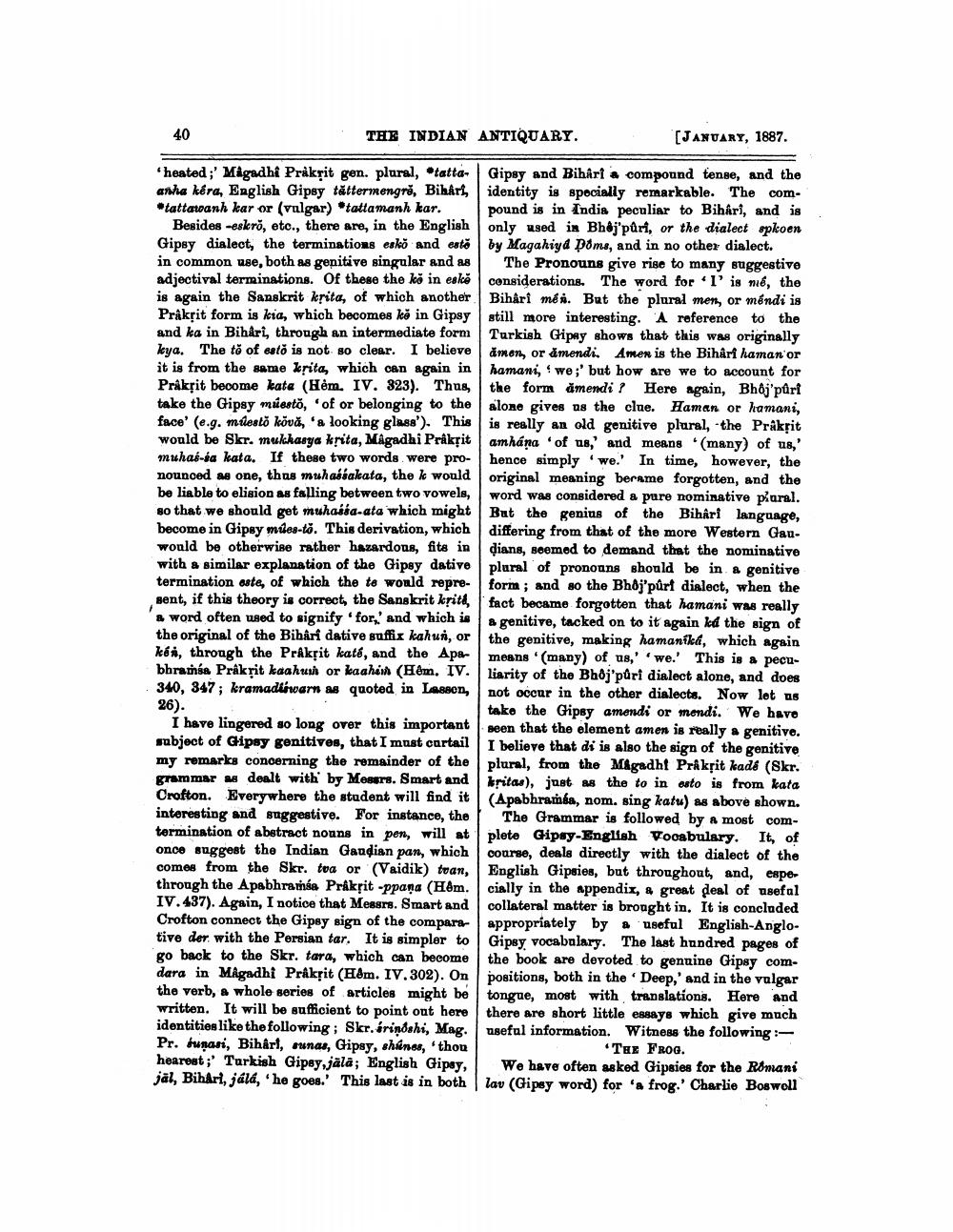________________
40
THE INDIAN ANTIQUARY.
'heated;' Magadhi Prakrit gen. plural, tatta anha kéra, English Gipsy tattermengre, Bihari, *tattawanh kar or (vulgar) *tattamanh kar.
Besides -eskro, etc., there are, in the English Gipsy dialect, the terminations esko and esto in common use, both as genitive singular and as adjectival terminations. Of these the ko in eske is again the Sanskrit krita, of which another Prakrit form is kia, which becomes ke in Gipsy and ka in Bihari, through an intermediate form kya. The to of esto is not so clear. I believe it is from the same krita, which can again in Prakrit become kata (Hêm. IV. 323). Thus, take the Gipsy miesto, of or belonging to the face' (e.g. miesto kövă, 'a looking glass'). This would be Skr. mukhasya krita, Magadhi Prakrit muhas-sa kata. If these two words were pronounced as one, thus muhassakata, the k would be liable to elision as falling between two vowels, so that we should get muhaisa-ata which might become in Gipsy múes-to. This derivation, which would be otherwise rather hazardous, fits in with a similar explanation of the Gipsy dative termination este, of which the te would represent, if this theory is correct, the Sanskrit krité, a word often used to signify for,' and which is the original of the Bihârî dative suffix kahun, or kén, through the Prakrit katé, and the Apabhramsa Prakrit kaahush or kaahim (Hêm. IV. 340, 347; kramadiéwarn as quoted in Lassen, 26).
[JANUARY, 1887.
Gipsy and Bihart a compound tense, and the identity is specially remarkable. The compound is in India peculiar to Bihari, and is only used in Bhej'puri, or the dialect spkoen by Magahiya Poms, and in no other dialect.
The Pronouns give rise to many suggestive considerations. The word for 1' is me, the Bihari més. But the plural men, or mendi is still more interesting. A reference to the Turkish Gipsy shows that this was originally amen, or amendi. Amen is the Bihârî haman or hamani, we;' but how are we to account for the form amendi? Here again, Bhôj'pûrî alone gives us the clue. Haman or hamani, is really an old genitive plural, the Prakrit amhána of us,' and means (many) of us,' hence simply we.' In time, however, the original meaning berame forgotten, and the word was considered a pure nominative plural. But the genius of the Bihar language, differing from that of the more Western Gaudians, seemed to demand that the nominative plural of pronouns should be in a genitive form; and so the Bhôj'pûrf dialect, when the fact became forgotten that hamani was really a genitive, tacked on to it again kd the sign of the genitive, making hamanika, which again means '(many) of us,' 'we.' This is a peculiarity of the Bhoj'pûrî dialect alone, and does not occur in the other dialects. Now let us take the Gipsy amendi or mendi. We have seen that the element amen is really a genitive. I believe that di is also the sign of the genitive plural, from the Magadh! Prakrit kadé (Skr. kritas), just as the to in esto is from kata (Apabhramés, nom. sing katu) as above shown. The Grammar is followed by a most complete Gipsy-English Vocabulary. It, of course, deals directly with the dialect of the English Gipsies, but throughout, and, espe cially in the appendix, a great deal of useful collateral matter is brought in. It is concluded appropriately by a useful English-AngloGipsy vocabulary. The last hundred pages of the book are devoted to genuine Gipsy compositions, both in the Deep,' and in the vulgar tongue, most with translations. Here and there are short little essays which give much useful information. Witness the following:
I have lingered so long over this important subject of Gipsy genitives, that I must curtail my remarks concerning the remainder of the grammar as dealt with by Messrs. Smart and Crofton. Everywhere the student will find it interesting and suggestive. For instance, the termination of abstract nouns in pen, will at once suggest the Indian Gaudian pan, which comes from the Skr. tea or (Vaidik) tean, through the Apabhramáa Prakrit -ppana (Hêm. IV.437). Again, I notice that Messrs. Smart and Crofton connect the Gipsy sign of the comparative der with the Persian tar. It is simpler to go back to the Skr. tara, which can become dara in Magadhi Prâkṛit (Hêm. IV. 302). On the verb, a whole series of articles might be written. It will be sufficient to point out here identities like the following; Skr. árindshi, Mag. Pr. bunasi, Bihari, sunas, Gipsy, shines, 'thou hearest; Turkish Gipsy,jälä; English Gipsy, jäl, Bihari, jálá, he goes.' This last is in both
"THE FROG.
We have often asked Gipsies for the Romani lav (Gipsy word) for 'a frog.' Charlie Boswoll




